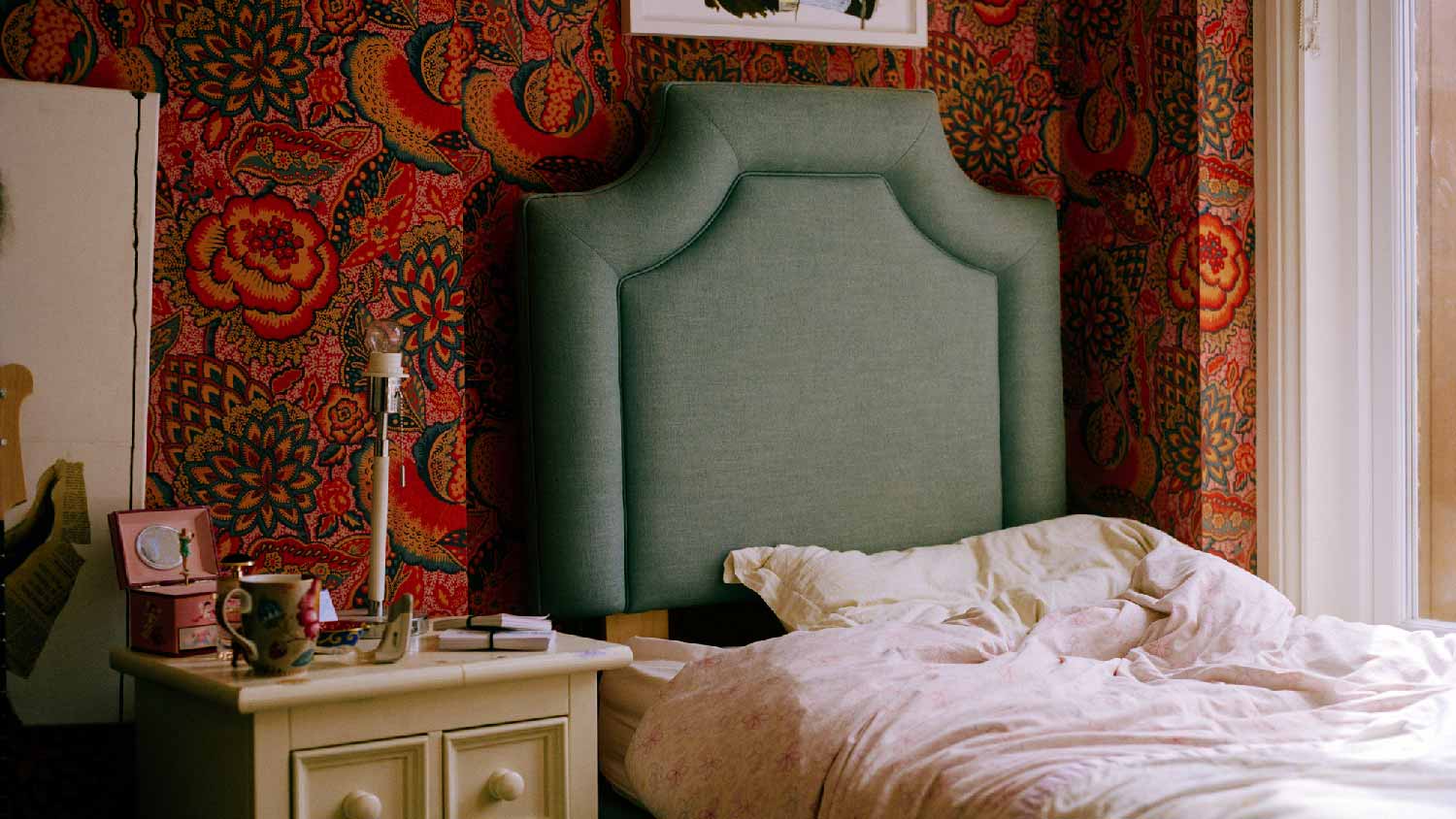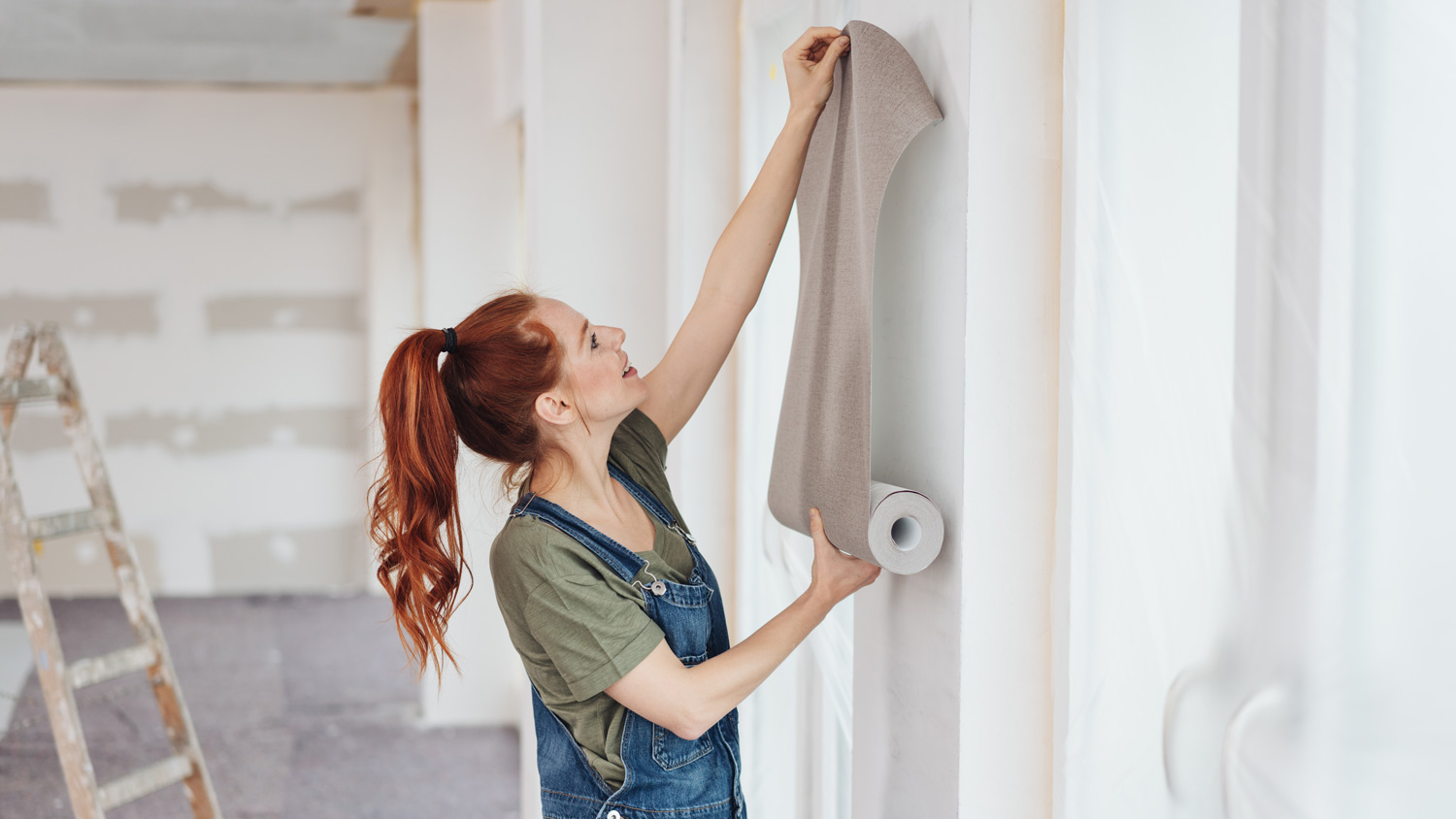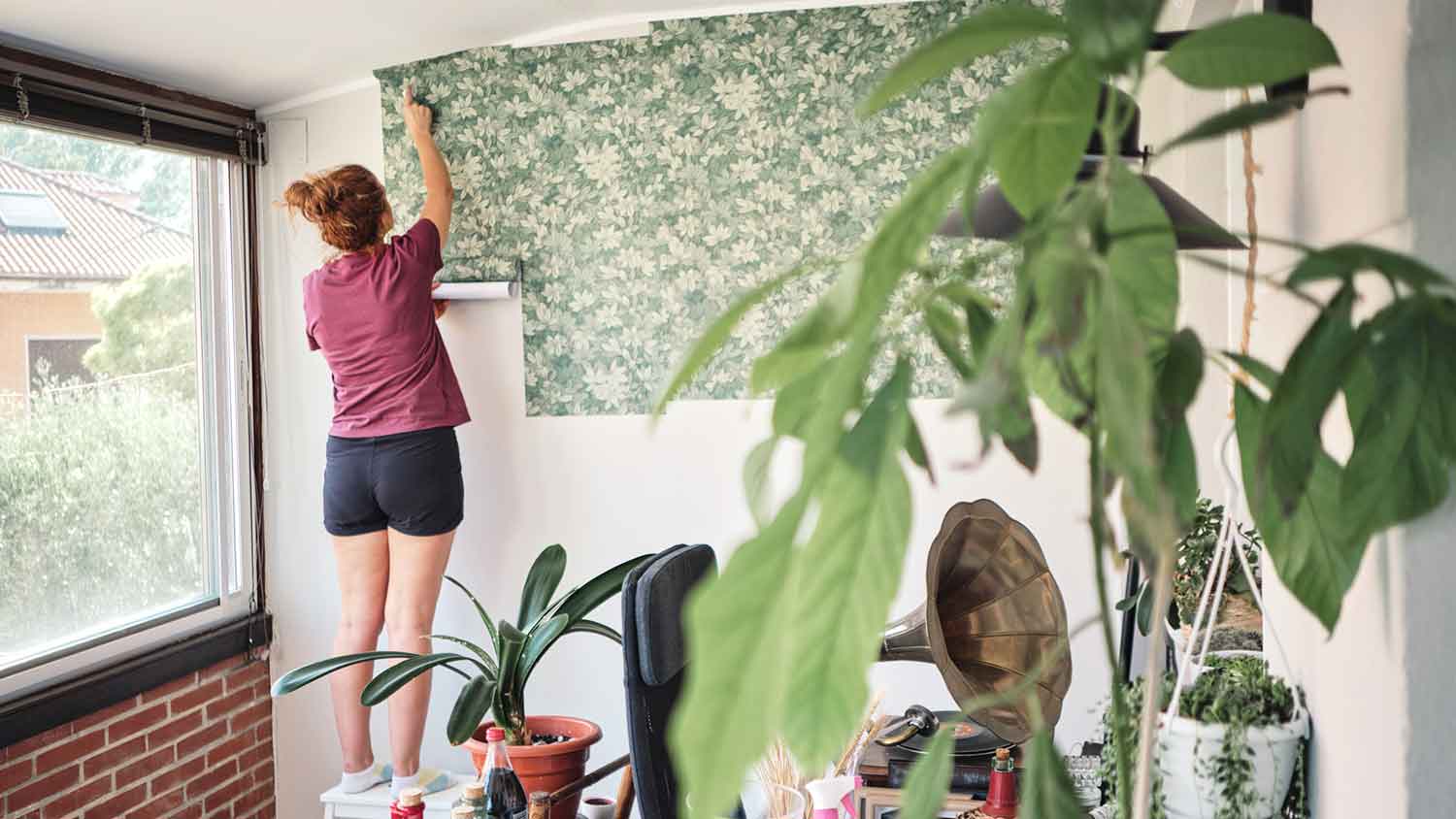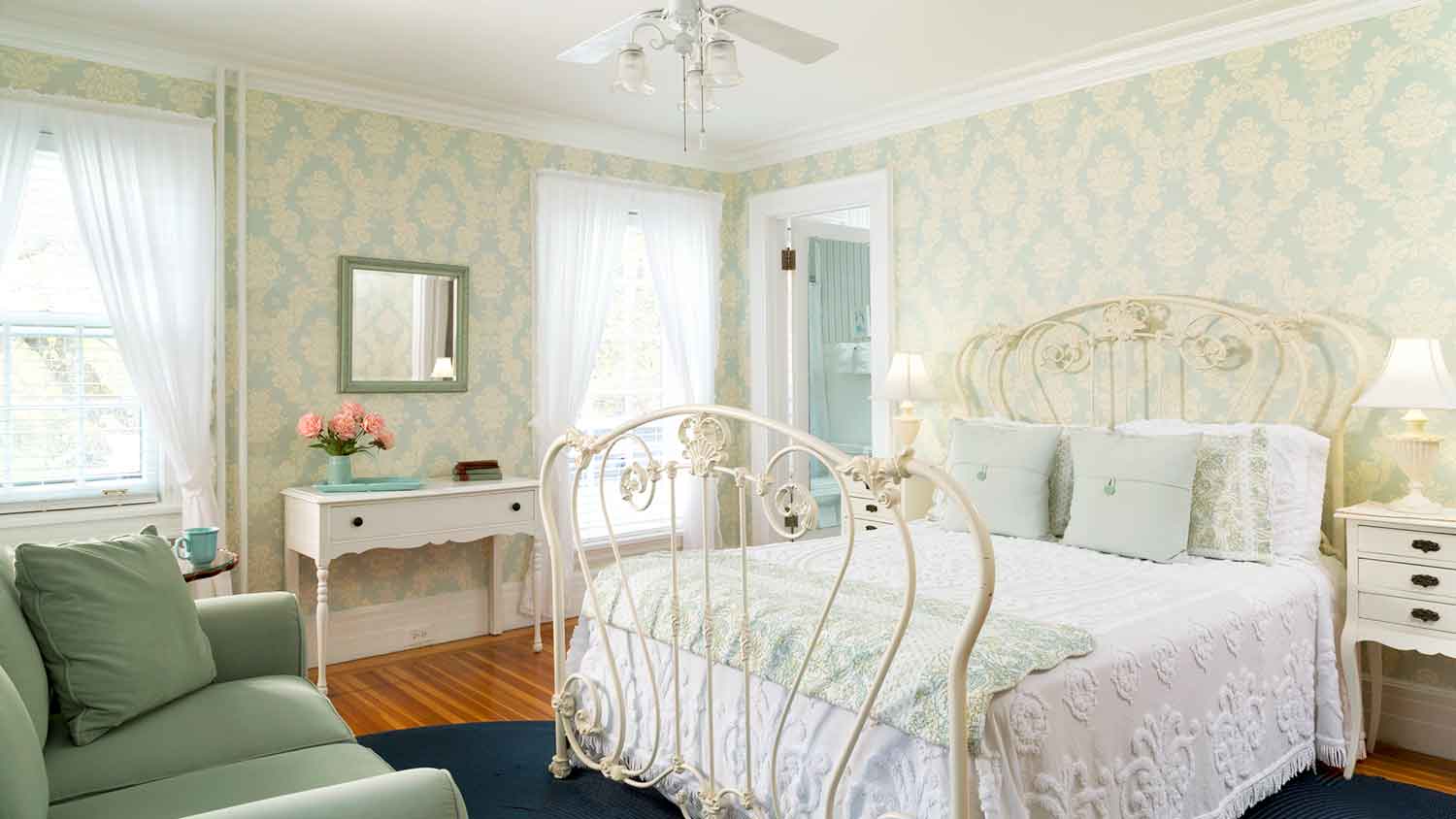
Planning to revamp your living space? Check out the best types of wallpaper, plus pros and cons to consider before choosing the best option for your home.
Wallpaper installation costs $600 on average, with most homeowners paying between $325 to $825. Your price depends on wall size, wallpaper type, labor, and prep work.


The main factors affecting the cost of wallpaper installation are wall size, type of wallpaper, and necessary prep work.
Wallpaper installation professionals charge between $30 and $80 per hour and ensure a quality installation.
Specialty wallpaper types and add-ons can impact your overall cost.
DIY wallpaper installation requires obtaining the necessary tools and supplies, costing $1 to $3 dollars per square foot.
This article was created using automation technology and thoroughly fact-checked and edited by an Angi Editor in accordance with our AI policy.
Wallpaper installation cost averages $600, with most homeowners spending between $325 to $825 for a standard room. Prices range from $3 to $8 per square foot, including both materials and labor. Factors like wallpaper type, wall condition, and prep work can affect your final price. Smaller projects with minimal wall space can run as low as $200, while larger projects with premium wallpaper can exceed $1,500.
Understanding the cost of wallpaper installation helps you budget for a fresh look in your home. This guide explores how room size, labor, and additional features shape your project’s total cost.
Many different elements influence wallpaper installation cost. Let’s break down the most important factors to help you plan your project.
The size of your wallpaper project is one of the biggest influences on wallpaper installation cost. The total square footage you want to cover directly affects the amount of material needed and the labor involved. Small spaces require less wallpaper and time, while larger or multi-room projects will increase your investment.
For a single accent wall, costs are lower than covering an entire room. Whole-home wallpapering, or even just a large living room, will require more planning and a higher budget. Ceiling height and wall shape, such as vaulted or irregular surfaces, can also add complexity and cost.
| Room/Wall Size | Description | Cost Range |
|---|---|---|
| Small bathroom | Up to 50 square feet | $200–$500 |
| Standard bedroom | 100 to 200 square feet | $400–$1,200 |
| Large living room | 250 to 400 square feet | $1,000–$2,400 |
| Accent wall | Single wall, 30 to 60 sq ft | $120–$500 |
| Whole home | 1,000+ square feet | $4,000–$10,000 |
Accent walls are a budget-friendly way to add style without the cost of a full-room installation. Multi-room or whole-home projects may qualify for volume discounts, but overall costs will be higher. High ceilings and unusually shaped walls require more labor and material, which increases your final price.
Specialty wallpaper types and add-ons can impact your overall cost. Peel-and-stick, vinyl, fabric, grasscloth, and custom mural wallpapers each have different price points and installation requirements. Textured or patterned wallpaper can be more expensive due to material cost and the extra time needed for precise alignment.
Accent walls, borders, and custom designs are popular add-ons but can add to your final bill. Removing old wallpaper or repairing and priming the wall before installation are additional services that increase your investment.
| Wallpaper Type | Description | Cost (Per Sq. Ft.) | Pros | Cons |
|---|---|---|---|---|
| Standard paper | Basic, non-washable | $0.50–$2 | Affordable, wide variety | Less durable, hard to clean |
| Vinyl | Washable, durable | $2–$5 | Easy to clean, good for kitchens | Can look less upscale |
| Fabric | Textured, high-end | $4–$10 | Luxurious look, soft finish | Expensive, harder to clean |
| Grasscloth | Natural, eco-friendly | $5–$12 | Unique texture, sustainable | Stains easily, tough to install |
| Peel-and-stick | Temporary, easy removal | $1–$6 | DIY-friendly, no paste needed | Less durable, limited designs |
| Custom mural | Printed to order | $10–$50 | Personalized, dramatic impact | Expensive, long lead times |
Professional wallpaper installation is handled by general contractors, wallpaper specialists, or experienced painters. Labor rates are charged per square foot, ranging from $1 to $4 per square foot, or by the hour, at $30 to $80 per hour. Some pros charge a minimum service fee, especially for small jobs.
Labor costs often include wall prep, installation, pattern matching, and cleanup. Regional variations can lead to higher prices in major cities or areas with high demand. Complex projects involving intricate patterns, many corners, or high ceilings will increase labor time and cost.
Most residential wallpaper installation projects do not require permits. However, permits might be needed for commercial spaces or historic homes where wall treatments are regulated. Permit fees, if required, are modest—often $50 to $200.
To avoid unexpected delays or costs, check with your local building department or historic preservation office before starting your project. A reputable installer can also advise if a permit is necessary.
Several other factors can affect your wallpaper installation cost. Below are some of the most common add-ons:
| Add-On | Description | Cost Range |
|---|---|---|
| Wall repairs/priming | Fixing holes, smoothing surface | $50–$300 per wall |
| Wallpaper removal | Removing old coverings | $1–$3 per sq. ft. |
| Furniture moving | Moving large items before install | $50–$200 |
| Design consultation | Professional design advice | $100–$500 |
| High ceilings | Extra labor for tall walls | $100–$500 per room |
| Delivery fees | Material transport | $25–$100 |
| Cleanup/disposal | Post-project cleaning | $50–$150 |
When considering wallpaper installation cost, compare the expenses and outcomes of doing it yourself versus hiring a professional. DIY projects save on labor but require tools, time, and skill.
DIYers pay only for materials and supplies—wallpaper, adhesive, smoothing tools, knives, ladders, and primers. These costs add up to about $1 to $3 per square foot. While you avoid labor fees, mistakes can waste material, and the finish may not last as long.
Professional installers charge more but offer experience, speed, and a high-quality result. Hiring a local wallpaper pro is recommended for complex patterns, large rooms, or specialty wallpapers.
| Installation Method | Materials Cost | Labor Cost | Total Cost | Pros | Cons |
|---|---|---|---|---|---|
| DIY | $100–$500 | $0 | $100–$500 | Lower cost, flexible timing | Risk of mistakes, time-consuming |
| Professional | $100–$500 | $500–$1,900 | $600–$2,400 | Expert finish, faster, warranty | Higher price, scheduling required |
DIY is best for small, simple projects or peel-and-stick wallpaper. For whole rooms, intricate patterns, or high-end materials, hiring a pro is the best way to ensure a durable, attractive result.
Deciding between repairing or replacing wallpaper depends on the extent and type of damage. Small issues—like minor tears, seam separation, or bubbles—can often be repaired for a fraction of the cost of replacement. Repairs cost $50 to $300.
Replacement is necessary if wallpaper is peeling extensively, stained, moldy, or simply outdated. If repair costs exceed 50% of the cost to replace, it’s best to start fresh. Wallpaper older than 10 years or those out of warranty are also good candidates for replacement.
Assess your wallpaper’s age, condition, and warranty status before deciding. Patchwork repairs can extend the life of newer wallpaper, but full replacement brings a fresh look and improved durability.
Wallpaper installation can enhance your home’s value, especially when using quality materials and on-trend designs. Fresh wallpaper creates a polished, welcoming atmosphere that appeals to buyers and guests.
Compared to paint or paneling, wallpaper offers unique patterns and textures for a custom look. While paint is less expensive, wallpaper can deliver a higher-end finish and longer lifespan when installed properly. The highest return on investment comes from professional installation, modern patterns, and materials that are easy to maintain.
To maximize value, choose designs with broad appeal, focus on key rooms, and ensure installation is flawless. Wallpaper adds both style and function, contributing to a home’s overall efficiency and aesthetic appeal.
Looking to save on wallpaper installation cost? Here are practical strategies:
Obtain multiple quotes from local professionals to find the best price.
Choose cost-effective wallpaper types, such as standard paper or vinyl, instead of high-end fabric or custom murals.
Prep your walls—remove old wallpaper, clean, and smooth surfaces yourself to cut down on labor fees.
Schedule installation during off-peak seasons, when pros may offer discounts.
Buy wallpaper in bulk or during sales to lower material costs.
Limit wallpapering to accent walls or smaller spaces to keep your total budget in check.
Reuse leftover wallpaper for small projects like lining drawers or decorating shelves.
Home is the most important place on earth, which is why Angi has helped more than 150 million homeowners transform their houses into homes they adore. To help homeowners with their next project, Angi provides readers with the most accurate cost data and upholds strict editorial standards. We extensively research project costs to develop the pricing data you see, so you can make the best decisions for you and your home. We rely on reputable sources, including the U.S. Bureau of Labor Statistics, academic journals, market studies, and interviews with industry experts—all to ensure our prices reflect real-world projects.
Want to help us improve our cost data? Send us a recent project quote to [email protected]. Quotes and personal information will not be shared publicly.
From average costs to expert advice, get all the answers you need to get your job done.

Planning to revamp your living space? Check out the best types of wallpaper, plus pros and cons to consider before choosing the best option for your home.

Is peel-and-stick wallpaper removable? Find out how to remove temporary wallpaper without causing damage to your walls.

Using wallpaper primer will help ensure your wallpaper adheres to your wall. Learn why wallpaper primer is necessary for the best results.

You can wallpaper over painted wallpaper if the wall is smooth and damage-free so that the newest layer can adhere well to it.

How long does peel-and-stick wallpaper last? Learn more about the factors that influence the lifespan of removable wallpaper, including quality and material.

Struggling to choose between wallpaper versus paint for your interior space? Learn how these options compare and which is best for your next project.